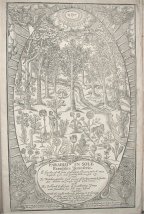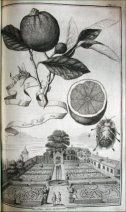|
The expert gardener : or, A treatise containing certaine necessary, secret and ordinary knowledges in grafting and gardening : with divers proper new plots for the garden. Also sundry expert directions to know the time and season when to sow and replant all manner of seeds. With divers remedies to destroy snails, canker-wormes, moths and other vermine. Faithfully collected out of sundry Dutch and French authors.
London : Printed by William Hunt, 1654.
54 p. : ill. ; 21 cm.
Page 34 [Tools]
 This volume was originally published in 1594 as The Orchard and the Garden and reprinted as the The Expert Gardener in 1640 and 1654 as one of three titles included in The Country-mans Recreation. All the illustrations, except for the tools, are diagrams of possible formal garden layouts. Many of the garden books of this time were dominated by such layouts, some extremely elaborate. The tools are of interest as they are readily identifiable.
This volume was originally published in 1594 as The Orchard and the Garden and reprinted as the The Expert Gardener in 1640 and 1654 as one of three titles included in The Country-mans Recreation. All the illustrations, except for the tools, are diagrams of possible formal garden layouts. Many of the garden books of this time were dominated by such layouts, some extremely elaborate. The tools are of interest as they are readily identifiable.
Cf. Hunt 170 note, 233, 262
Woodcuts.
Parkinson, John, 1567-1650.
Paradisi in sole paradisvs terrestris, or, A choise garden of all sorts of rarest birth, time of flowring, names, and vertues to each plant, useful in physick, or admired for beauty : To which is annext a kitchin-garden furnished with all manner of herbs, roots, and fruits, for meat or sawce used with us. With the art of planting an orchard of all sorts of fruit-bearing trees and shrubs, shewing the nature of grafting, inoculating, and pruning of them. Together with the right ordering, planting and preserving of them, with their select vertues: all unmentioned in former herbals. Collected by John Parkinson.
The 2d impression much cor. and enl.
London : Printed by R.N. and are to be sold by R. Thrale, 1656.
[12], 612, [16] p. : ill. ; 33 cm.
Frontispiece.
 Parkinson's delight in gardens emerges clearly in these pages. Divided into three sections -- flower garden, kitchen garden, and orchard -- the book, when published in 1629, was the first on horticulture printed in England. The title is a play on the author's name; it translates as "terrestrial paradise of park in sun." On the title page near the center in the background is the legendary Scythian lamb or lamb of Tartary, half plant, half animal. It was accepted as a real creature from the 14th through the 17th centuries. The woodcut is signed Switzer with an A above. It is generally believed to be the work of Christoph Switzer who came to England in 1614 and was highly regarded for his woodcuts and engravings. The printer is undoubtedly Roger Norton.
Parkinson's delight in gardens emerges clearly in these pages. Divided into three sections -- flower garden, kitchen garden, and orchard -- the book, when published in 1629, was the first on horticulture printed in England. The title is a play on the author's name; it translates as "terrestrial paradise of park in sun." On the title page near the center in the background is the legendary Scythian lamb or lamb of Tartary, half plant, half animal. It was accepted as a real creature from the 14th through the 17th centuries. The woodcut is signed Switzer with an A above. It is generally believed to be the work of Christoph Switzer who came to England in 1614 and was highly regarded for his woodcuts and engravings. The printer is undoubtedly Roger Norton.
Hunt 267
Woodcuts.
Volkamer, Johann Christoph, 1644-1720.
Nurnbergische Hesperides, oder, Grundliche Beschreibung der edlen Citronat- Citronen- und Pomerantzen-Fruchte : wie solche in selbiger und benachbarten Gegend, recht mogen eingesetzt, gewartet, erhalten und fortgebracht werden, Samt einer ausfuhrlichen Erzehlung der meisten Sorten, welche theils zu Nurnberg wurcklich gewachsen, theils von verschiedenen fremden Orten dahin gebracht worden, auf das accurateste in Kupffer gestochen, in vier Theile eingetheilet und mit nutzlichen Anmerckungen erklaret : Beneben der Flora, oder curiosen Vorstellung verschiedener raren Blumen samt einer Zugabe etlicher anderer Gewachse, und ausfuhrlichem Bericht, wie ein richtig zutreffende Sonnen-Uhr im Gartenfeld von Bux anzulegen, und die Garten nach der Perspectiv leichtlich aufzureissen : Wie auch einem Bericht von denen in des Authoris Garten stehenden Columnis milliaribus ... / herausgegeben von J.C.V.
Nurnberg : Zu finden bey Johann Andrea Endters seel. Sohn & Erben, 1708-1714.
2 v. ([8], 255, [13] p., [115] leaves of plates (some double, some folded); [20], 239, [2] leaves, [132] leaves of plates (some double, some folded)) : ill., maps ; 36 cm.
Page 166 "Limon dolce"
 This work could as well be part of the botany of places. Volklamer was a wealthy Nuremberg merchant who was especially devoted to the cultivation of citrus. Linnaeus refers to the first part and even named a genus Volkameria, since merged with Clerodendum. He hired a number of talented engravers and artists to illustrate the book, which is stunning with its giant beribboned fruit floating in the sky over towns, estates, and gardens. Often, the manor would be identified, as here, "In Hrn Doct Silberrad garten." The gardens in the volume depict fine examples of the formal style with precise geometrical layouts popular at this time.
This work could as well be part of the botany of places. Volklamer was a wealthy Nuremberg merchant who was especially devoted to the cultivation of citrus. Linnaeus refers to the first part and even named a genus Volkameria, since merged with Clerodendum. He hired a number of talented engravers and artists to illustrate the book, which is stunning with its giant beribboned fruit floating in the sky over towns, estates, and gardens. Often, the manor would be identified, as here, "In Hrn Doct Silberrad garten." The gardens in the volume depict fine examples of the formal style with precise geometrical layouts popular at this time.
Hunt 420
Engravings.
Line Engraving - Intaglio
 A line engraving is made by incising lines on a plate, usually copper, with a burin, a tool with a sharp V shaped tip, looking something like an awl. The lines can vary in width depending on how deeply the cut is made. The sheet, or plate as it is termed, is then rubbed with ink and then wiped clean, leaving the ink in the cut lines and the surface free of ink. The plates are printed on an engraving press where the plate and paper are put under great pressure by rollers. The ink in the incised lines is picked up by the paper from the plate. The process for all prints that are produced from pulling ink from the recesses, not the surfaces, is called intaglio.
A line engraving is made by incising lines on a plate, usually copper, with a burin, a tool with a sharp V shaped tip, looking something like an awl. The lines can vary in width depending on how deeply the cut is made. The sheet, or plate as it is termed, is then rubbed with ink and then wiped clean, leaving the ink in the cut lines and the surface free of ink. The plates are printed on an engraving press where the plate and paper are put under great pressure by rollers. The ink in the incised lines is picked up by the paper from the plate. The process for all prints that are produced from pulling ink from the recesses, not the surfaces, is called intaglio.
|
![]()

![]()

![]()